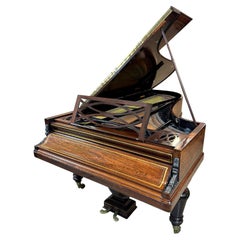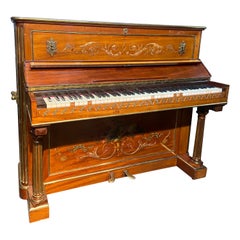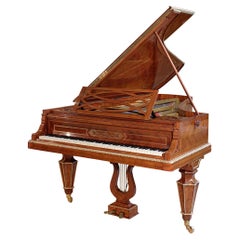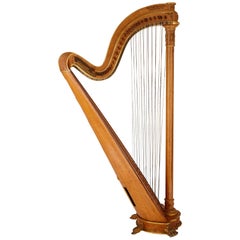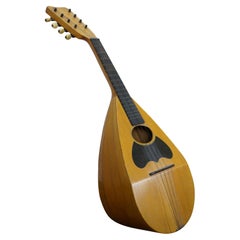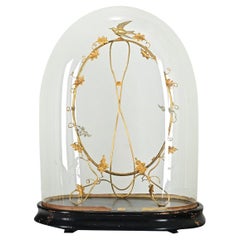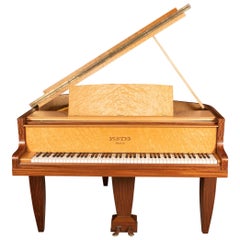Pleyel & Compie Furniture
to
1
2
2
4
1
1
3
4
3
2
2
1
4
4
4
4
4
3
12,306
3,886
2,479
2,226
Creator: Pleyel & Compie
Pleyel Grand Piano, Paris 1870
By Pleyel
Located in Littleton, CO
This Pleyel concert grand piano crafted in Paris in 1870 is a timeless masterpiece that embodies the elegance and craftsmanship of 19th-century French piano manufacturing. Pleyel instruments are renowned for their exceptional quality and rich musicality, representing the pinnacle of piano design in the Romantic era, and this piano – an early example of the technological innovation of cross-stringing that was burgeoning during the period – is one in a series of only six ever produced.
This piano is in extraordinarily immaculate condition with nearly every original part, including the soundboard, pristine ivory keys, and the brass inlay in its beautifully figured walnut cabinet. Candle stands slide forward on either side of the collapsable music desk.
This piano was first purchased by the French Count Charles Étienne Gustave Le Clerc, count of Juigné (1825-1900), one of the wealthiest landowners in Brittany and a member of the French National Assembly, later a member of the House of Representatives, and in late life, the Senate.
The piano was restored in 1997 at Maison Erard by master restorationist Frits Janmaat in Amsterdam, and later conditioned by Edwin Beunk.
In recent years, some of Europe's finest historically-informed musical artists played this Pleyel in PBS concert performances in collaboration with the late Sergiu Luca.
Standing on substantial carved legs and brass wheels, the piano exudes a majestic presence through the graceful lines of its Second Empire style cabinet that embodies the period's aesthetics.
The keyboard, meticulously crafted from ivory and ebony, is a testament to the attention to detail in every aspect. Its 85 keys...
Category
17th Century French Romantic Antique Pleyel & Compie Furniture
Materials
Walnut
$125,000
19th Century Pleyel French Upright Piano Hand Painted Decoration and Fluted Legs
By Pleyel
Located in Sofia, BG
This rare upright piano was made by Pleyel in France in September 1871 according to the Pleyel Archives found at Musée de la Musique.
The natural wood cabinet is beautifully decorated with hand painted floral garlands. The piano sides are square and it has fluted, columnar legs resting on original castors. The instrument...
Category
Late 19th Century French Antique Pleyel & Compie Furniture
Materials
Brass
$10,275 Sale Price
55% Off
French Mid-19th Century Concert Grand Piano Signed Pleyel
By Pleyel
Located in West Palm Beach, FL
A spectacular French mid-19th century, circa 1855, Louis XVI st. tulipwood parquetry and ormolu mounted, Model 2 Concert Grand Piano, signed Pleyel...
Category
19th Century French Louis XVI Antique Pleyel & Compie Furniture
Materials
Ormolu
Large Gilt Bronze Mounted Maple Harp by Pleyel, Wolff, Lyon and Cie
By Pleyel
Located in London, GB
This fine antique harp dates from the second half of the 19th century and was made in France by Pleyel, Wolff, Lyon and Cie. The renowned Parisian firm ma...
Category
Late 19th Century French Antique Pleyel & Compie Furniture
Materials
Ormolu, Bronze
Related Items
Antique Lyon & Healy Lakeside Maple Bowl Back Mandolin 24"
By Lyon & Healy
Located in Dayton, OH
Late 19th to early 20th century Lakeside eight string, bowl back mandolin guitar by Lyon & Healy. Made of maple with angled cant and head, segmented bowl back. Ebonized oxbow shaped ...
Category
Early 1900s American Victorian Antique Pleyel & Compie Furniture
Materials
Hardwood, Maple
$175 Sale Price
30% Off
H 23.75 in W 8 in D 23.75 in
French 19th Century Glass Dome with Brass Decoration
Located in Baton Rouge, LA
Popular in the 19th century, domed glass displays offered protection for portico clocks and flora & fauna specimens without compromising visibility. Inside this cloche is an oval eas...
Category
19th Century French Art Nouveau Antique Pleyel & Compie Furniture
Materials
Silver, Brass
19th Century Louis XIV Style Marquetry Baby Grand Piano by Collard & Collard
By Collard & Collard
Located in Los Angeles, CA
A very fine Anglo-French 19th century rosewood, palisander, amboyna and satinwood marquetry (inlaid) art-case baby grand piano, the works by "Collard & Collard". The intricately deco...
Category
Late 19th Century English Neoclassical Revival Antique Pleyel & Compie Furniture
Materials
Bronze
$75,600 Sale Price
20% Off
H 40.25 in W 72 in D 55.5 in
Upright piano. Towards the beginning of the 20th century.
Located in Madrid, ES
Upright piano. Towards the beginning of the 20th century.
Upright or wall piano with a wooden body with marquetry elements on the central panel of the uppe...
Category
20th Century European Other Pleyel & Compie Furniture
Materials
Other
19th Century French Grand Tour Iron Model of the Arc de Triomphe
Located in West Palm Beach, FL
19th century French grand tour iron model of the Arc de Triomphe, in two parts, the fine cast iron model of the Arc de Triomphe with a mirrored top. Raised on a oval ebonized wood and metal chain link fenced base
Model of Arc de Triomphe...
Category
Late 19th Century French Grand Tour Antique Pleyel & Compie Furniture
Materials
Metal, Iron
$1,160 Sale Price / set
20% Off
H 12 in W 14 in D 11 in
English Regency Gilt Figural and Ebonized Dital Harp, Maker E. Light, Circa 1815
Located in Charleston, SC
English Regency gilt stenciled figural and floral ebonized dital harp signed by maker Edward Light. Retailed at Srohl Foley place London, Early 19th century.
Category
1810s English Regency Antique Pleyel & Compie Furniture
Materials
String, Wood, Ebony, Giltwood
$12,800
H 34 in W 14 in D 6.25 in
Pleyel Upright Piano Satinwood Neoclassical Inlay Fluted, Columnar Legs
Located in Leeds, GB
An 1893, Pleyel upright piano with a satinwood cabinet.
Entire cabinet features intricate, Neocalssical style inlay. The front panels feature a symmetri...
Category
1890s French Neoclassical Antique Pleyel & Compie Furniture
Materials
Brass
$16,999
H 46.46 in W 55.91 in D 25.2 in
French Gilt Bronze Brooch by Line Vautrin
By Line Vautrin
Located in Atlanta, GA
A brooch in gilded bronze by French art jeweler Line Vautrin circa 1950s-1960s. The unusual model depicts the mathematical sign of infinity, on which appears in relief inscription of...
Category
1950s French Mid-Century Modern Vintage Pleyel & Compie Furniture
Materials
Bronze
Large Gilt Bronze Feuille Box by Line Vautrin
By Line Vautrin
Located in Atlanta, GA
A large cast bronze powder box (poudrier) by French Parisian art jeweler Line Vautrin (1913-1997) circa 1945-1950. The box called "Feuille" (Leaf) features an irregular leaf form wit...
Category
1940s French Mid-Century Modern Vintage Pleyel & Compie Furniture
Materials
Bronze
Liberace Autographed Vintage Schoenhut Toy Grand Piano
By Schoenhut
Located in Hamilton, Ontario
Made by the renowned American toy manufacturer in approximately 1920, this wooden toy baby grand piano has been autographed in two places by the legendary Liberace. The piano shows o...
Category
Early 20th Century American Victorian Pleyel & Compie Furniture
Materials
Brass
19th Century Carved Wood Santos with Gilt Decoration
Located in Buchanan, MI
19th century carved wood Santos with gilt decoration.
Category
19th Century Italian Antique Pleyel & Compie Furniture
Materials
Gold Leaf
A German 19th Century Louis XVI Style Burr Walnut Bechstein Concert Grand Piano
By Bechstein Piano Company
Located in Los Angeles, CA
A Very Fine German 19th Century Louis XVI Style Burr Walnut Bechstein Concert Grand Piano, Serial No. 5655. The beautifully crafted Grand piano, raised on three tapered barrel shaped legs, with an intricately carved ornate music desk and original keys. Circa: 1872.
Length: 80 inches (203.2 cm)
Width: 59 inches: (149.9 cm)
Height (top closed): 38 5/8 inches (98.1 cm)
C. Bechstein Pianofortefabrik
C. Bechstein Pianofortefabrik AG (also known as Bechstein) is a German manufacturer of pianos, established in 1853 by Carl Bechstein.
Before Bechstein
Young Carl Bechstein studied and worked in France and England as a piano craftsman, before he became an independent piano maker. His first pianos were made for other companies.
C. Bechstein
C. Bechstein piano factory was founded on 1 October 1853 by Carl Bechstein in Berlin, Germany.
Carl Bechstein set out to manufacture a piano able to withstand the great demands imposed on the instrument by the virtuosi of the time, such as Franz Liszt. In 1857, Hans von Bülow (Liszt's son-in-law) gave the first public performance on a Bechstein grand piano by performing Liszt's Piano Sonata in B minor in Berlin
By 1870, with endorsements from Franz Liszt and Hans von Bülow, Bechstein pianos had become a staple in many concert halls and private mansions. By that time three piano makers, all of which were founded in 1853, became established as the industry leaders across the world: Bechstein, Blüthner and Steinway & Sons.
In 1881 Bechstein began supplying pianos to Queen Victoria. A gilded art-case piano was delivered to Buckingham Palace, followed by several more Bechstein pianos to Windsor Castle and other royal residences. By January 1886 they were among the piano manufacturers holding a Royal Warrant as a supplier to the Queen. Several British embassies across the world acquired Bechstein pianos.
In 1885, Bechstein opened a branch in London, that eventually grew to become the largest showroom and dealership in Europe. By 1890 showrooms had been opened in Paris, Vienna, and Saint Petersburg. On 31 May 1901, Bechstein Hall, built at a cost of £100,000, was opened next to the company's London showroom at 36-40 Wigmore Street. Between 1901 and 1914, C. Bechstein was the largest piano dealership in London. At that time, Bechstein was patronized by the tsars of Russia, the royal families of Spain, Belgium, the Netherlands, Italy, Sweden, Norway, Austria and Denmark, and other royalty and aristocracy. The list of royal clients of Bechstein may be found on the soundboard of vintage Bechstein pianos made before the Second World War. The list is part of the original Bechstein trademark logo; it can be seen under the strings in the center of a piano's soundboard.
The signature of Carl Bechstein
The years from the 1870s through 1914 brought Bechstein their most dramatic increase in sales. In 1880 a second Bechstein factory was opened in Berlin, and the third factory was opened in 1897 in Berlin-Kreuzberg. Production reached 3,700 pianos annually in 1900, and 4,600 in 1910, making Bechstein the largest German manufacturer of high-end pianos. At that time, about three quarters of production went to international markets, especially Britain and the Commonwealth, and Russia.
Carl Bechstein died in 1900, and the Bechstein company continued to operate under the management of his sons.
Between 1900 and 1914 C. Bechstein was one of the leading piano makers in the world, employing 1,200 craftsmen and workers by 1913 and making five thousand pianos per year.
First World War
C. Bechstein suffered huge property losses in London, Paris, and St. Petersburg during World War I. The largest loss was in London. Although the company's position in the United Kingdom was initially unaffected, with the company still listed as holding a Royal Warrant in January 1915, Warrants to both King George V, and his wife Queen Mary were cancelled on 13 April 1915. Bechstein was not the only musical concern to be affected by growing anti-German sentiment: there were earlier attempts, led by William Boosey, to boycott German music altogether. In 1915, despite being a Baronet and Privy Counsellor, Sir Edgar Speyer, who was then funding the Proms, was forced to leave the country. Following the passing of the Trading with the Enemy Amendment Act 1916 the British arm of the company was wound-up on 5 June 1916, all Bechstein property, including the concert hall and showrooms full of pianos, were seized as "enemy property" and closed. In 1916 the hall was sold as alien property at auction to Debenhams for £56,500. It was renamed Wigmore Hall, and then re-opened under the new name in 1917. All 137 Bechstein pianos at the Bechstein showrooms were confiscated too, and became property of the new owner of the Hall. After a dispute with his brother, Edwin Bechstein left the company and was paid off.
Eventually the Bechstein factory resumed full-scale production during the 1920s. At that time, technical innovations and inventions of new materials and tools, as well as improvements in piano design and construction, had allowed Bechstein to become one of the leading piano makers again.
The most successful models were the updated "A"-185 and "B"-208 grand pianos. The upright pianos became more popular after the war, and C. Bechstein were successful with its upright pianos Model-8 and Model-9, both of which have been considered the finest upright pianos.
As the company was changed into a joint-stock company 1923, Edwin Bechstein and his wife Helene, bought themselves back into the company as shareholders.
In 1930 the company collaborated with German electrical goods manufacturer Siemens under Nobel laureate Walther Nernst to produce one of the first electric pianos...
Category
19th Century German Louis XVI Antique Pleyel & Compie Furniture
Materials
Bronze
$34,850 Sale Price
53% Off
H 38.63 in W 80 in D 59 in
Previously Available Items
20th Century Pleyel Model 3Bis Baby Grand Piano
By Pleyel
Located in Austin, TX
This French Early 20th Century Pleyel baby grand piano is truly exceptional. The Pleyel brand is legendary and has been favored by renowned composers such as Chopin, Debussy, and Ravel for its rich and unique sound. This particular piano is in remarkable condition, with beautifully restored walnut wood veneer, delicate yet sturdy legs, and perfectly balanced proportions. The soundboard is in its ideal original condition, offering an authentic Pleyel sound, and the hammers, strings, and tuning pins are all original yet functional. The cast iron plate is adorned with exquisite floral ornamentations, adding to the elegance of the instrument.
The keys are made of highly refined ivory, providing a distinctive and sophisticated touch. With the serial number found on the piano and the archives of the Musee de la Musique, the piano's precise origin has been traced back to 1922. Pleyel pianos...
Category
1920s French Louis XV Vintage Pleyel & Compie Furniture
Materials
Walnut
Pleyel Art Deco Baby Grand Piano #197175, circa 1939
By Pleyel
Located in Stamford, CT
Art Deco baby grand piano in gorgeous mahogany and bird's-eye maple veneers. This is a unique, petite, apartment size baby grand piano in the...
Category
1930s Art Deco Vintage Pleyel & Compie Furniture
Materials
Birdseye Maple, Mahogany
French Ormolu-Mounted Kingwood and Vernis Martin Piano by Pleyel and Barbedienne
By François Linke, F. Barbedienne Foundry, Pleyel
Located in Queens, NY
A magnificent French ormolu bronze mounted kingwood, marquetry, and vernis martin piano by Pleyel. Bronze mounts are by Ferdinand Barbedienne (back of some of the mounts are stamped ...
Category
19th Century French Antique Pleyel & Compie Furniture
Materials
Bronze
H 43 in W 58 in D 72 in
Pleyel & Compie furniture for sale on 1stDibs.
Pleyel & Compie furniture are available for sale on 1stDibs. These distinctive items are frequently made of wood and are designed with extraordinary care. There are many options to choose from in our collection of Pleyel & Compie furniture, although brown editions of this piece are particularly popular. Many of the original furniture by Pleyel & Compie were created in the louis xv style in france during the 19th century. Prices for Pleyel & Compie furniture can differ depending upon size, time period and other attributes — on 1stDibs, these items begin at $14,866 and can go as high as $210,000, while a piece like these, on average, fetch $72,554.
Questions About Pleyel & Compie Furniture
- Where are Pleyel pianos made?1 Answer1stDibs ExpertApril 5, 2022Pleyel pianos are made in Paris, France. After a brief time in the south of France, Pleyel et Cie downsized its factory and began creating their famous piano designs in the City of Love. On 1stDibs, you can find Pleyel pianos from some of the top sellers around the world.
- Are Pleyel pianos still made?1 Answer1stDibs ExpertApril 5, 2022No, sadly Pleyel Pianos are no longer in production. The high-quality piano maker and a personal favorite of composer Chopin closed its Paris doors in 2013. You can shop a selection of rare Pleyel pianos from some of the world’s top reputable sellers on 1stDibs.
